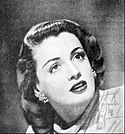Eugenie Baird

Eugenie Baird (* 18. September 1924 als Eugenie Mead; † 12. Juni 1988) war eine amerikanische Sängerin der Jazz- und Unterhaltungsmusik.
Baird sang beim 1943/4 Casa Loma Orchestra, aber auch mit Spike Jones, Mel Tormé, Louis Armstrong, Tony Pastor und mit Cab Calloway (1949). Sie trat 1944/5 in der Radioshow („Kraft Music Show“ bei NBC) von Bing Crosby auf, später auch in der Fernsehshow von Ed Sullivan. 1943 war sie an dem Spielfilm „The Sky's the Limit“ beteiligt, wo sie durch das Glen Gray Orchestra begleitet wurde (My Shining Hour). Sie war die erste Sängerin des Casa Loma Orchesters.
Als Sängerin trat sie in dem Broadway-Stück „Angel in the Wings“ (Broadway, 1947/8) auf. 1958 spielte sie das Album „Eugenie Baird sings - Duke's Boys play Ellington“ (FreshSound) mit Musikern wie Ben Webster ein.
Später war sie als Jingle-Sängerin erfolgreich und heiratete den Vorstandsvorsitzenden des Schreibmaschinenherstellers SCM Corporation.[1]
Weblinks
- Eugenie Baird bei IMDb
- Biografie (Memento vom 4. März 2016 im Internet Archive) (englisch)
- Eugenie Baird bei AllMusic (englisch)
- Biographie (französisch)
- Eugenie Baird bei Discogs
Einzelnachweise
- ↑ Simon The Bigbands, Schirmer 1981, S. 121, er zitiert seinen Review von 1944 ..the prettiest girl i´ve ever seen in front of a band and in addition the posessor of one of the prettiest voices
| Personendaten | |
|---|---|
| NAME | Baird, Eugenie |
| ALTERNATIVNAMEN | Mead, Eugenie (Geburtsname) |
| KURZBESCHREIBUNG | US-amerikanische Sängerin |
| GEBURTSDATUM | 18. September 1924 |
| STERBEDATUM | 12. Juni 1988 |
Auf dieser Seite verwendete Medien
Photo of Eugenie Baird from an ad in the 1950 trade magazine Sponsor.
- The two page ad for Lang-Worth is not copyright marked; copyrights for Sponsor magazine would not apply to the journal's ads. There are no surviving copyrights for the magazine. A check for renewals was done in periodicals for 1977. The search continued at copyright.gov for 1978. There were no renewals listed for Sponsor magazine. There's no indication the publication was renewed.
- There are no copyright marks on the ad.
- US Copyright Office page 3-magazines are collective works (PDF)
"A notice for the collective work will not serve as the notice for advertisements inserted on behalf of persons other than the copyright owner of the collective work. These advertisements should each bear a separate notice in the name of the copyright owner of the advertisement."
- United States Copyright Office page 2 "Visually Perceptible Copies The notice for visually perceptible copies should contain all three elements described below. They should appear together or in close proximity on the copies.
- 1 The symbol © (letter C in a circle); the word “Copyright”; or the abbreviation “Copr.”
- 2 The year of first publication. If the work is a derivative work or a compilation incorporating previously published material, the year date of first publication of the derivative work or compilation is sufficient. Examples of derivative works are translations or dramatizations; an example of a compilation is an anthology. The year may be omitted when a pictorial, graphic, or sculptural work, with accompanying textual matter, if any, is reproduced in or on greeting cards, postcards, stationery, jewelry, dolls, toys, or useful articles.
- 3 The name of the copyright owner, an abbreviation by which the name can be recognized, or a generally known alternative designation of owner.1 Example © 2007 Jane Doe.")
